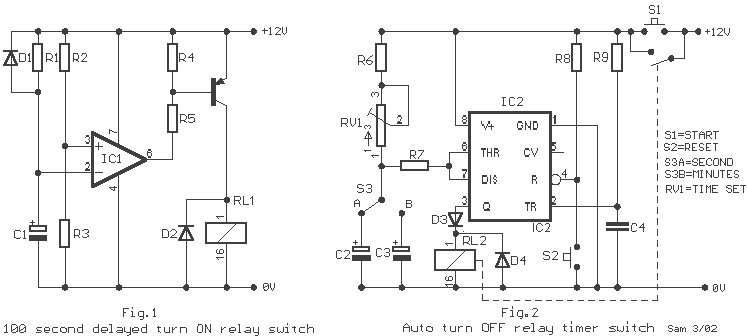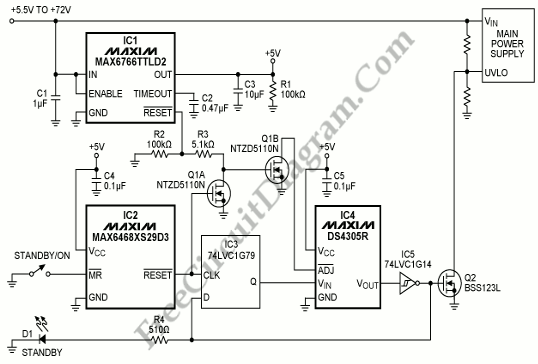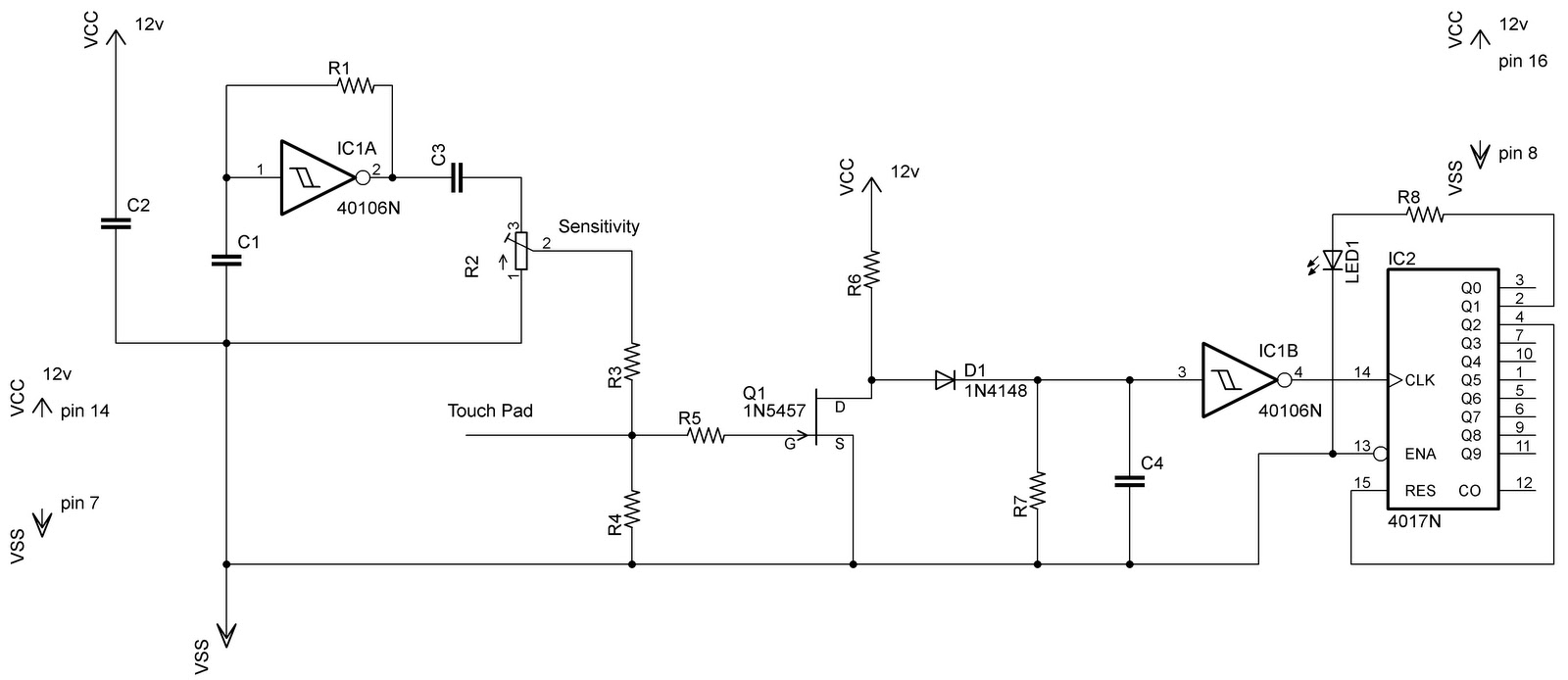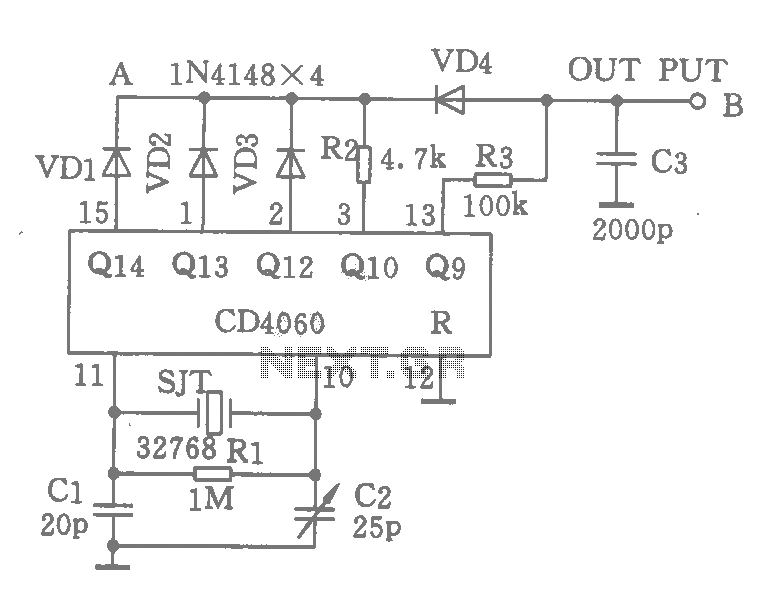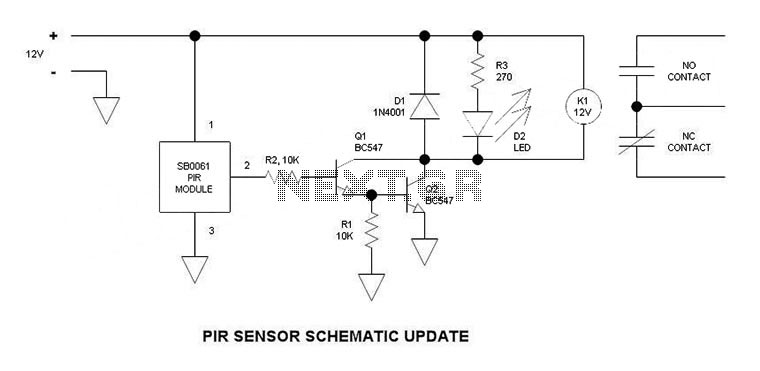
Switch control circuit diagram mcu
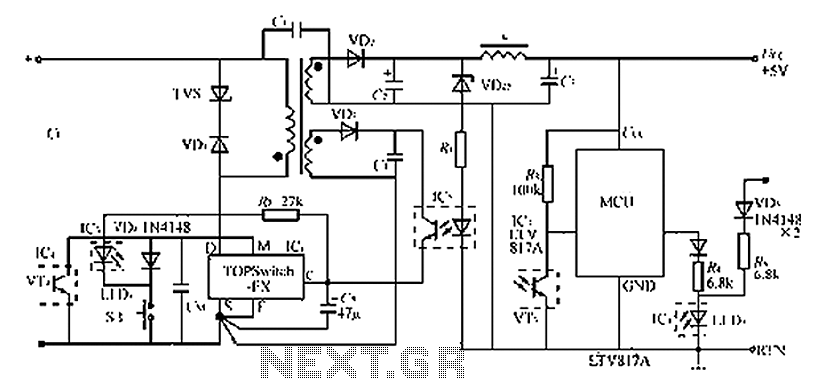
The circuit diagram of the TOPSwitch FZ chip switching power supply is controlled by microcontrollers (MCUs). The microcontroller can be utilized with inkjet printers, laser printers, and other computer peripherals. The TOPSwitch FX, which constitutes the switching power supply control circuit, is depicted in the figure. The main components of the switching power supply include the TOPSwitch FX (IC1) and an optocoupler (IC2). The control circuit comprises a microcontroller (MCU), two LTV817A linear optocouplers (IC3, IC4), and a push-button switch (SB). The signal is generated only when the SB is pressed, and it is valid only when the button is released. The SB does not require an anti-shake circuit due to the soft start time of the switching power supply (approximately 10ms) and the initialization and reset delay time of the MCU, which helps avoid interference from button press jitter. The SB must be pressed continuously to ensure the activation of the power supply by the MCU. After the MCU initialization and reset, it detects a start signal sent by IC3, which then passes through the power lock switch IC4. The optocouplers IC3 and IC4 consist of LED light tubes and phototransistors, represented as LED3 and VT3, and LED4 and VT4, respectively. LED3 is connected between the control terminal and the upper part of the SB, with VT3 connected to the logic input of the MCU. Under normal conditions, no current flows through LED3, rendering IC3 inactive. The logic output from the MCU passes through isolation diodes and resistors (R4, VD6) to energize LED4. VT4 is connected between the M and S terminals. The M terminal provides a self-limiting function, negating the need for an additional limiting resistor for VT4. The multifunctional terminal CM serves as a noise cancellation capacitor. Upon the first press of the SB, VD4 conducts, allowing the M and S terminals to power through VD4, placing the TOPSwitch FX in three-terminal mode. At this point, the multifunction terminal (M) and switching frequency setting terminal (F) are inactive, and current flows through LED3, signaling the MCU to start. If the power switch is initially in the OFF state (M-side floating) during the first power-on initiated by pressing SB, the +5V output voltage (UCC) supplies the operating voltage for the MCU. After receiving the start signal, the MCU commands VT4 to conduct, keeping the switching power in the ON state and providing a normal output. When the SB is pressed again, it sends a shutdown signal, prompting the MCU to execute the shutdown procedure, ensuring the inkjet printer head stops in a safe position. After completing the shutdown procedure, the MCU disables VT4, leaving the M terminal vacant and placing the switching power in shutdown mode. In this low power state, the TOPSwitch FX consumes only 160mW from a 230VAC supply. If a DVD power switch is employed, the shutdown procedure and data set state can be stored in the EEPROM, preventing data loss even during power failures.
The circuit operates with a focus on efficiency and safety, ensuring that the power supply can be activated and deactivated seamlessly through the microcontroller's control logic. The design incorporates feedback mechanisms via the optocouplers, which facilitate communication between the power supply circuit and the MCU, enabling precise control over the power state. The use of a push-button switch (SB) simplifies user interaction, while the soft start feature prevents sudden power surges that could damage connected peripherals. The inclusion of EEPROM storage for state retention during power loss enhances the reliability of the system, making it suitable for applications where data integrity is crucial. The overall architecture reflects a well-thought-out approach to managing power supply operations in electronic devices, particularly those requiring stable and controlled power input, such as printers and other computing peripherals. As shown in FIG TOPSwitch FZ chip switching power supply circuit diagram is controlled by the MCUs. The microcontroller can use inkjet printers, laser printers and other comput er peripherals TOPSwitch FX constituted by a switching power supply control circuit shown in Fig. Switching power supply mainly composed TOPSwitch FX (IC1), optocoupler (IC2) components. The control circuit includes a microcontroller (MCU), two LTV817A linear optocoupler (IC3, IC4), push button switch SB. Signal is generated only when you press the SB is only valid when lifting signal does not work. The SB would not need anti-shake circuit, because the switching power supply soft start time (about 10ms) and the MCU initialization and reset delay time can play a role, you can avoid the time jitter interference when pressed SB; and only when the switch is pressed at least to achieve the above time, the switch to turn on the power by MCU.
This will require the SB press in the end, instead of single click, to ensure power supply starter. After the completion of MCU initialization and reset detected IC3 sent to the start signal, and then go through the power lock switch IC4. Optocoupler IC3, IC4 of LED light tube and phototransistor, respectively LED3 and VT3, LED4 and VT4 representation.
Now LED3 connected between the control terminal and the SB upper, VT3 connected to the logic input MCU. No current through LED3 under normal, IC3 does not work. Logic output MCU through isolation diodes and resistors R4 VD6 then positive LED4 of. VT4 is connected between the M, S end. M by itself end limiting function, it does not require additional VT4 limiting resistor. CM multifunctional end noise cancellation capacitor. When a user first press SB, VD4 conduction, M and S pole end through VD4 turned, TOPSwitch FX namely in three terminal mode, multi-function terminal (M) and switching frequency setting terminal (F) does not work, the current through LED3 on this point, VT3 give MCU start signal.
If the power switch is initially in the OFF state (M-side floating) for the first time the power is turned on by pressing SB, + 5V output voltage UCC provides operating power supply voltage for the MCU. MCU orders after receiving a start signal VT4 conduction, switching power remains in the ON state, the normal output.
When the user presses again on the issue of SB shutdown signal, MCU receives the signal after the implementation of the shutdown procedure, the ink jet printer head stop at a safe place. Once you perform the shutdown procedure, MCU will make it VT4 off the M terminal vacant, switching power shutdown mode, when TOPSwitch FX in a low power state, when UI 230VAC the chip consumes only 160mW.
If the DVD is used when the power switch, the shutdown procedure and the data set state can be stored in the E2PROM, yet they are not lost even after power failure.
The circuit operates with a focus on efficiency and safety, ensuring that the power supply can be activated and deactivated seamlessly through the microcontroller's control logic. The design incorporates feedback mechanisms via the optocouplers, which facilitate communication between the power supply circuit and the MCU, enabling precise control over the power state. The use of a push-button switch (SB) simplifies user interaction, while the soft start feature prevents sudden power surges that could damage connected peripherals. The inclusion of EEPROM storage for state retention during power loss enhances the reliability of the system, making it suitable for applications where data integrity is crucial. The overall architecture reflects a well-thought-out approach to managing power supply operations in electronic devices, particularly those requiring stable and controlled power input, such as printers and other computing peripherals. As shown in FIG TOPSwitch FZ chip switching power supply circuit diagram is controlled by the MCUs. The microcontroller can use inkjet printers, laser printers and other comput er peripherals TOPSwitch FX constituted by a switching power supply control circuit shown in Fig. Switching power supply mainly composed TOPSwitch FX (IC1), optocoupler (IC2) components. The control circuit includes a microcontroller (MCU), two LTV817A linear optocoupler (IC3, IC4), push button switch SB. Signal is generated only when you press the SB is only valid when lifting signal does not work. The SB would not need anti-shake circuit, because the switching power supply soft start time (about 10ms) and the MCU initialization and reset delay time can play a role, you can avoid the time jitter interference when pressed SB; and only when the switch is pressed at least to achieve the above time, the switch to turn on the power by MCU.
This will require the SB press in the end, instead of single click, to ensure power supply starter. After the completion of MCU initialization and reset detected IC3 sent to the start signal, and then go through the power lock switch IC4. Optocoupler IC3, IC4 of LED light tube and phototransistor, respectively LED3 and VT3, LED4 and VT4 representation.
Now LED3 connected between the control terminal and the SB upper, VT3 connected to the logic input MCU. No current through LED3 under normal, IC3 does not work. Logic output MCU through isolation diodes and resistors R4 VD6 then positive LED4 of. VT4 is connected between the M, S end. M by itself end limiting function, it does not require additional VT4 limiting resistor. CM multifunctional end noise cancellation capacitor. When a user first press SB, VD4 conduction, M and S pole end through VD4 turned, TOPSwitch FX namely in three terminal mode, multi-function terminal (M) and switching frequency setting terminal (F) does not work, the current through LED3 on this point, VT3 give MCU start signal.
If the power switch is initially in the OFF state (M-side floating) for the first time the power is turned on by pressing SB, + 5V output voltage UCC provides operating power supply voltage for the MCU. MCU orders after receiving a start signal VT4 conduction, switching power remains in the ON state, the normal output.
When the user presses again on the issue of SB shutdown signal, MCU receives the signal after the implementation of the shutdown procedure, the ink jet printer head stop at a safe place. Once you perform the shutdown procedure, MCU will make it VT4 off the M terminal vacant, switching power shutdown mode, when TOPSwitch FX in a low power state, when UI 230VAC the chip consumes only 160mW.
If the DVD is used when the power switch, the shutdown procedure and the data set state can be stored in the E2PROM, yet they are not lost even after power failure.
Warning: include(partials/cookie-banner.php): Failed to open stream: Permission denied in /var/www/html/nextgr/view-circuit.php on line 713
Warning: include(): Failed opening 'partials/cookie-banner.php' for inclusion (include_path='.:/usr/share/php') in /var/www/html/nextgr/view-circuit.php on line 713
